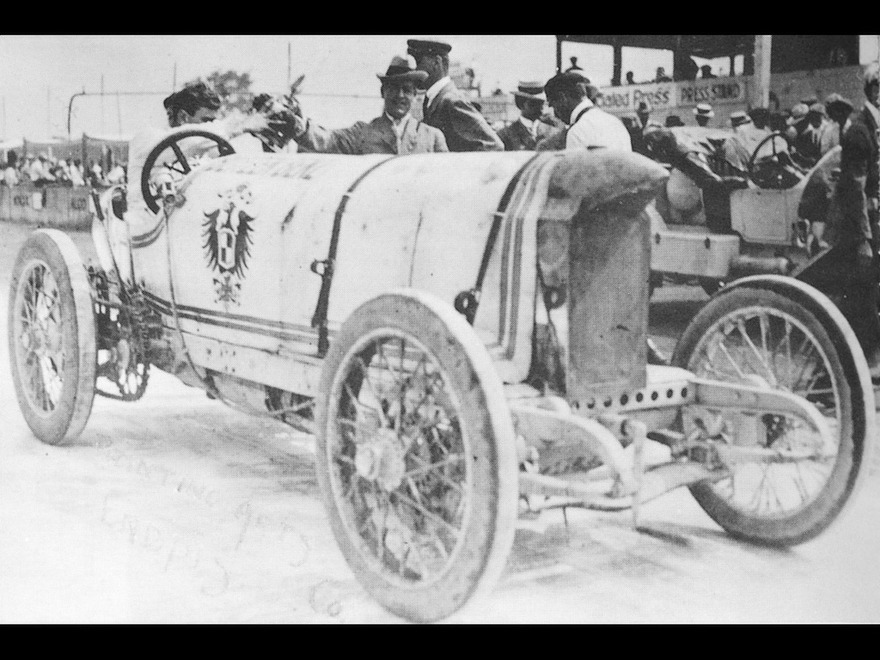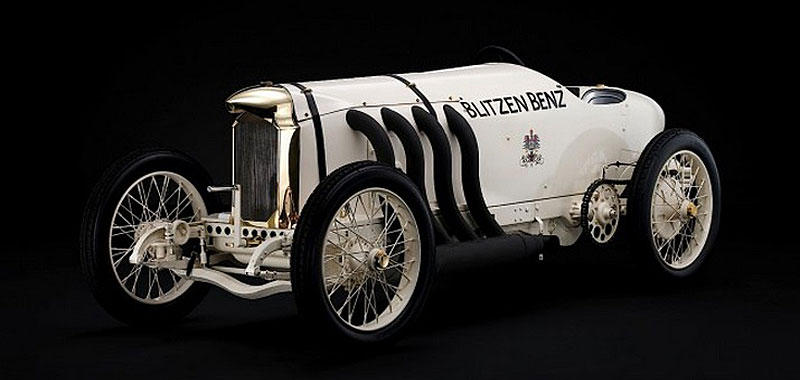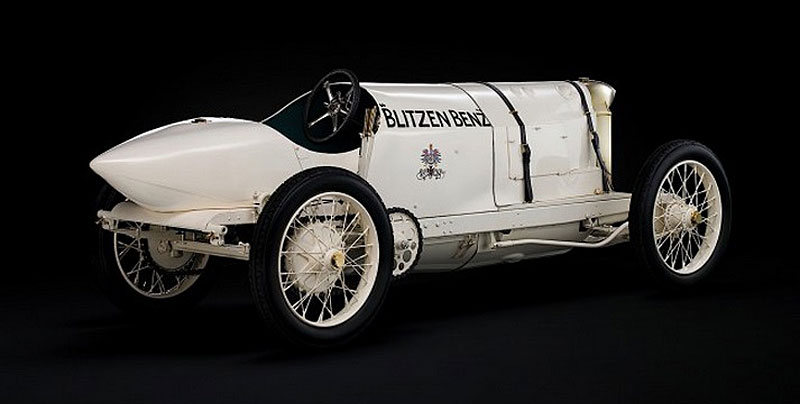Tremendous roar rolls in the cloudless Florida sky. Hair on the spectators’ heads stands on end and mouths drop open in amazement. 15 miles of Daytona Beach. Third day of Indianapolis Motor Speedway. On Saturday August 21, 1909 37,000 spectators are watching with fascination how Barney Oldfield wins the race with the new 26.20 sec record.
Sounding like a thunder on the start and fast as a lightning on the finish line the little-known Benz 200HP flies at over 85.5 mph speed. The pilot holding the supersensitive wheel with his injured hand wins showing an outstanding performance. The car with the formidable appearance becomes the triumph of the German technology.
Faster than any vehicle in the world. The lightning which passes the airplanes. The light which leaves behind all railway speed records of the pre-war period (1903: 210 km/h). Veyron pales in comparison with the supercar with the German name Blitzen Benz.
This strange vehicle was created by Karl Benz. He thought cars would achieve the dreams of the whole mankind by providing individual mobility. In the beginning of the 20th century each manufacturer of “self-moving carriages” considered it a matter of honour to construct a racing car. Thinking racing was only for entertainment of the audience the ancestor of all cars was not falling under the influence of such fashion for a long time. Meanwhile its competitors were earning a lot of money on the pathological need for speed and the ballyhoo around racing performances.
Using Benz GP — the model of 1908 — as the basis, the German inventor decided to create the fastest car in the world. Benz considered his first version not ambitious enough —150 hp engine of the Grand Prix racing car was accelerating up to 184 km/h turning at 1,500 revolutions per minute. Torque went to rear wheels with the help of a couple of massive straight chains. By increasing the engine capacity up to 21.5 litres the genius engineer was aiming at breaking the magic barrier of 200 km/h — it was the maximum speed cars could achieve at that time. After some very accurate adjustments the high four-cylinder engine shifted backwards was producing 200 hp. Huge cylinders with 185 mm piston diameter and the volume of 5-litre buckets were producing such noise that the sound of Fokker E1 — which used to be the thunder in the German skies — seemed nothing but a whisper. The roar was even louder because the system lacked silencer. Each cylinder had an exhaust pipe with all of them situated on the left side of the hood.
In order to make the car more aerodynamic, the wooden-spoked wheels were fitted with aluminium plates. The car had a narrow all-metal white body ready to pierce the space any time with its sharp nose shaped like a predator’s beak. Wide-apart wheels of large diameter together with narrow tires provided excellent road adhesion and made the car look like a monster.
Mechanical drum brakes, stiff suspension without shock-absorbers typical for that time and ladder-type frame were not innovative in 1909. But at the same time a car with 2.77-metre wheelbase weighed around 1270 kg.
Creating a saloon for two people, Karl Benz took into account the space for the control rods and placed them on the side of the saloon. The final touch was added by Grand Prix car chassis. The car itself was assembled around an enormous engine.
And so it was the moment for the beau-monde of the motor racing sport to see the new Benz 200HP. It seemed like the European racing tracks would be too narrow for it. The first victory in 1-kilometre race manifested the success of Benz. The courage of its pilot Erle Fritz knew no measure. He showed great performance on the tracks near Frankfurt behind the wheel of an almost uncontrollable car. Only one word was floating in the air. «Blitzen”, sounded the bass of men. „Blitzen“, echoed the ringing voices of women. That was the beginning of the racing career of Blitzen Benz supercar.
After that came the first record set on the Brooklands circuit. The French pilot Victor Hemery covered 1-kilometre distance with the incredible 31.32 sec result. Like a white lightning on the grey asphalt of Great Britain on March 17, 1910 Blitzen Benz reached 205.66 km/h speed. The car which conquered the top speed put into the shade the results achieved by the previous champions from Darracq.
Having tried all tracks of the good old Europe Benz proved that all of them were too short and narrow for it. There was no place on those tracks to break out and dash with maximum performance. So Blitzen was fitted with a new body and sent to America.
The brave man who dared to sit inside the white monster twice showed new speed records to the audience without any effort. Sitting behind the wheel of Blitzen Benz, Barney Oldfield set the new record in the very first race in Daytona Beach — 211.97 km/h. And thought it had not been officially registered, the American pressmen were proudly informing the world about the unique car, transferring its name into Lightning Benz.
Success led Karl Benz to further improvement of car’s power pack and body. The creator of the fastest supercar managed to keep its invention on the champion throne for quite a long time. The audience was always happy to see the White Lightening on the racing tracks. Having no equal Blitzen Benz was not only able to make a mash on thousands of spectators but also to fall into disgrace of the American Automobile Association. Back then in 1910 they managed to disqualify Barney Oldfield but he was replaced by another daredevil.
Bob Burman was destined to leave his mark in history. The pilot used all the potential of Blitzen Benz during the Dayton Beach race on April 23, 1911. The wild racer and lightning-supercar reached 228.1 km/h setting the official record which remained unbeatable till 1919.
Only two out of 6 Blitzen Benz cars survived till our days. And only one of them is displayed in public at the Mercedes-Benz museum in Germany. The lightning-car is a 20th century phenomenon which is beyond any explanations. It celebrated its 100th anniversary not so long ago. It was a great achievement to break 200 km/h speed limit in those days. And this achievement was made by Karl Benz and Mercedes-Benz company.
A car which still inspires awe and respect, served as a model of human courage and desire to use speed in tune with time till the mid 30’s. Karl Benz enclosed the insuperable part of human existence into the savage four-cylinder heart which had a wild desire to fly faster than time itself and which was accompanied by thunder and lightning.















